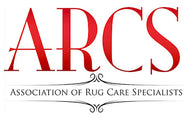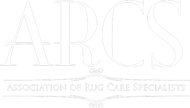2024 Second Quarter Newsletter
Dye Bleed
Pat Slaven
There are many discussions, conversations and even rants about Dye Bleed on the Rug Cleaners Forum. I’ll be very up front about this column, there are NO easy, magical solutions in the last paragraph. There is no elixir that will erase the issue quickly and easily that you can purchase in 3 easy payments (plus shipping and handling of course).... Dye bleed is nasty stuff. You can fill that in with any expletive of your choosing. It's a headache, extra work and cost for you and your staff.
I traveled in Guatemala in late winter and marveled at the hand woven and hand embroidered clothing in vibrant colors. One store had racks and shelves of incredible cotton textiles. But there were bins of ‘seconds’ off to the side, very advantageously priced. I took a close look and quickly realized many of these exquisite textiles had bled when they were washed. Much of the dye bleed was red, and the common fiber was cotton. The standard issues with cotton dyeing are excess unreacted dye on the fiber surface, poor quality dyes or dyeing with the wrong temperature and poor auxiliaries for the specific dye stuff. Plus of course, insufficient rinsing in a country with limited water resources.
Does any of this sound familiar? Cotton is dyed with different classes of dye than wool, however many of the dyeing problems apply to wool and silk also.
Rug Cleaners clean largely clean wool, nylon and polyester. And of course some silk (and the evil ‘art silk’ aka rayon….) Needless to say, nylon and polyester are rarely problems. Hum this is a topic for another column….
For our audience - most dye bleed issues occur with natural dyes or acid dyes on handwoven wool or silk rugs.
Acid dyes (and their various sub categories) are well suited for dyeing protein fibers (wool & silk) and also nylon. Yes nylon is a synthetic fiber but it has reactive groups similar to those in both wool and silk. Briefly these dyes form strong bonds with amide linkages in an acidic solution at an elevated dye bath temperature. They are efficient and cost effective for the dyer as the dye bath exhaust. This means most of the dye attaches and reacts with the fiber and little is left in solution when everything is done right. Dye formulas are generally easy to reproduce. (12)
Natural dyes are more complicated but are often classified as an Acid dye or Vat dye and in the case of natural acid dyes, often require a mordent to bond with the fiber.(2) Vats dyes are beyond the scope of this article!
So Back to Why Dye Bleed?
There is unreacted dye hanging out on the fiber surface just waiting to ruin your day. This is less common with rugs woven in larger studios and more commercial ventures. However these dyes can loosen in certain situations discussed below.
Rugs made in small studios, rural areas etc. which are hand spun/hand dyed/hand woven, are beautiful. But do consider the access that an area has to water for yarn processing, scouring, dyeing and rinsing. And consider the possible skills of the dye operation. The dyeing can be done at a temperature too low to completely react with the fiber. The dye bath may have an issue with the auxiliaries (generally acid) which help facilitate the reaction between the dye and fiber. Natural dyes can also have mordenting issues.
Also it's rare, but wool that has not been completely scoured before dyeing, can have lanolin on the surface that can prevent dyes from penetrating and completely reacting with the wool fiber. Again these are possible issues. Larger operations still have days when the power goes off and the quality control on the dye operations may not be perfect. (1,3) Rinsing is important and requires water.
Silk - is beautiful. Wool from sheep breed for rug wool, can generally be dyed at somewhat higher temperatures. Silk which is similar, but not the same chemically, requires much more gentle treatment and is dyed at lower temperatures. (1,2) Silk requires more care and skill from the dyer.
Why else - dye that has dissociated from the fiber and goes back into solution during cleaning. This is possible if the pH changed. How can that happen you may ask? Urine is a common reason. It is an acid when fresh and converts to a base that we know today as ammonia. Acid dyes are applied in an acidic solution and bind to the fiber. Putting a base (e.g. ammonia) on wool dyed with acid dyes is a great way to loosen those bonds. (1,2) So old pee on a wool rug can be a bigger problem than just Fluffy’s fermented urine odor.
While the rug industry and even retail DIY products are careful about the pH of detergents and cleaning products. A homeowner may have done a DIY cleaning job with a higher pH soap such as Fels Naptha.(4) Non-manufacturer websites claim the pH is 9.5-10.5 which is quite basic.
What to Look Out For:
This is not rocket science, if you have been in the industry for longer than a hot minute - deep reds, blues and black on hand woven rugs have the potential for dye bleed.
And any rug with a hint of dye bleed from a previous cleaning, is a potential problem.
Rug inspection is paramount. OK, I’m preaching to the choir here as they say. You all have your procedures and checklists. Anything vaguely suspicious, do a physical check for possible dye bleed by rubbing with a dry white cloth, then with a wet one.(5)
With new clients and new rugs - look for any hints of previous bleeding and remediation. Look out for over correction/ dye stripping e.g border areas that are a few shade lighter than surrounding yarn.
And finally hope for good luck.
Reminder - I look for themes, trends and member concerns that likely affect many, and pick one or two for the column. If you have an idea, my email is listed below.
References:
- Synthetic Dyes for Natural Fibers l. Knutson (1986)
- Howard Needles - Textile Fibers, Dyes, Finishes and Processes: A Concise Guide (1986)
- Big Book Of Handspinning, Alden Amos (2001)
- AATCC Test Method 165 Color Fastness to Crocking -Textile Floor Coverings - 2019

Book Review
The Slight Edge by Jeff Olson
The Slight Edge is an excellent book for anyone wanting to take their goals to the next level. Jeff Olson shares how to “turn simple daily disciplines into massive success and happiness.” The book dives into the fact that the slight edge (your habits) is always working in your life. Habits work in both the positive and in the negative. Your life is shaped by choices and habits that you create every day. Those habits and choices compounded over time will either take your life on a positive or a negative path. For example, you can choose to work out, eat healthy and live an active lifestyle or you can eat unhealthy, drink too much alcohol, and live a sedentary life. Both choices are easy to make but the benefits compounded over time will be drastically different. I highly recommend this book for people wanting to make a shift in their personal, business, financial and/or relational habits to make the positive changes needed for success.
Upcoming Classes
Discover Rug Cleaning
(Knoxville, TN)
Dates: June 1, 2024
Location: Carr's Rug Cleaning in Knoxville, TN

Founded by Bob Carr, Carr's Rug Cleaning has been a leader in the textile cleaning industry since 1984. We were the first in Knoxville to become Certified Carpet and Upholstery Cleaning technicians as well as the first Certified Rug Specialist in the state of Tennessee. We place a huge emphasis on training and education in rug and carpet cleaning, doing our best to stay up to date on the most advanced cleaning techniques. We do not use a one-size-fits-all approach for our services. With meticulous attention to detail, we employ the best methods and professional cleaning agents for your particular fabric, stone, or hardwood floor, and their specific issues.
Intermediate In-Plant Rug Cleaning
(Dallas, TX)
Dates: October 2-4, 2024
Location: Oriental Rug Cleaning Co., Dallas, TX

The class consists of three intensive eight-hour days taught primarily on the work floor of an operational wash plant. Topics covered will be cleaning chemistry, spotting, rug identification, learning to ‘read’ and identify rug construction, rug intake assessment, rug washing, drying theory, and finishing after wash. Hands-on portions of the class will demonstrate the practical application of all that theory on an active wash floor in real-time. The hands-on training will focus on wet cleaning; students will wash a lot of rugs and have the opportunity to try a range of techniques and observe the results. More than just an opportunity to work and learn on a high-production wash floor, students will gain a broader understanding of the cleaning process and how it applies to their own businesses. The fee for the class includes lunch for the three days, handouts, and all teaching materials. A short test will be given at the end of the class session. You will need to bring wash boots.
Discover Rug Cleaning (Palm Desert, CA)
Dates: February 24, 2024
Location: The Rug Salon by Spot Out

The Rug Salon by Spot Out, Inc. is Coachella Valley’s premier state-of-the-art rug washing facility. Located in Palm Desert, CA, The Rug Salon has been cleaning area rugs and high-end upholstery in our cleaning facility since 2014. During this class, you will have the opportunity to put on your wash boots and see how to wash rugs. Whether you’re just starting out with very little equipment, or you are a little more seasoned and want to see how to use a tumble duster, wash tub, and centrifuge, this class has something for everyone. All skill levels are welcome. This is a great opportunity to see how a medium-sized rug plant runs and operates. The Rug Salon has two Master Rug Cleaner certified staff members as well as an area-only Certified Rug Specialist. This is a hands-on class so, BYOB (bring your own boots) and come see what rug washing is all about.
Advanced In-Plant Rug Cleaning (Indianapolis, IN)
Dates: Rescheduled - TBD
Location: Oriental Rug Cleaning of Indianapolis in Indianapolis, IN

Jordan King and Andrija Malbasa lead this intensive 3-day, hands-on rug washing and dye correction class including a full day spent on advanced rug spotting & finishing techniques used in top rug plants across the country.
This class introduces chemicals and techniques used to remove dye migration and stains commonly used in wash plants around the world, exploring with firsthand experiences, their benefits and learning to understand their limitations. Participants receive ample time to experience hands-on wash floor rug washing, dye stripping, fringe color correction, and urine stain removal with reducing agents and oxidizers. The third day we will spend time teaching to evaluate a rug’s ‘after wash’ condition and assess what final finishing procedures it takes to deliver top quality with your rug cleaning service! As a bonus, attendees leave with a Formulation Guide to the reducing and oxidizing products used during the event and a list of various suppliers to purchase from.
Official Announcement!
Join ARCS November 1st – 16th, 2024 for a dream trip to Turkey! Great food, wonderful people, beautiful fall weather.


Enjoy a guided tour through Istanbul, Bursa, Izmir, Usak, and the beaches of Antalya.

Private tours of rug washing and ‘antiquing’ plants, restoration facilities, wool spinning mills, rug museums, collectors, dealers, and an ongoing discussion of the rug industry as it is today with the people in that industry.




If you are a member of ARCS, please join our ARCS Member page on Facebook!
For great information and sharing!





